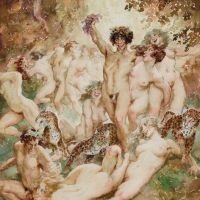28. NORMAN LINDSAY

Norman Lindsay turned to the medium of watercolour painting relatively late in his career, having exhausted the possibilities of pen drawing and engraving. Up until this time, he had been primarily concerned with drawing technique however it was Blamire Young (1862-1931) who first taught Lindsay the technical profundities of watercolour. The challenges associated with this medium are many however once mastered, the results can be greatly rewarding. We find our methods by experiment and failure, and no one can lay down precise principles for a medium so fluid and accidental as watercolour. To this day, I never sit down to a watercolour without enduring the suspense of an experiment designed to go wrong and very often it does go wrong. The percentage of comparatively successful experiments is about one in four of my output.1 Looking at Lindsays vast watercolour oeuvre, there is no doubt that he successfully mastered the technique. The artist was able to achieve superb results both in his draughtsmanship and handling of colour.
Bacchanalian Scene of 1941 is Lindsay at his best the scene depicts a festival of Bacchus, the Greco-Roman god of wine, freedom, intoxication and ecstasy. Here, Bacchus is seen clutching a bunch of grapes above his head whilst a throng of festival-goers surrounding him enjoy the lively atmosphere. To add to the hedonism, three leopards stealth casually through the naked figures in a flourish of excess. Lindsays other interpretations of the theme have often generated mixed opinions, the case of Pollice Verso being just one example.2 The first major controversy of Norman Lindsays career erupted in Sydney in 1904 when the pen and ink drawing was displayed at the Royal Art Society of New South Wales. Pollice Verso depicted a figure on the cross with a troop of bacchanals passing by on foot and a figure of Bacchus bestride a horse. As the procession passes the cross, the figures look back derisively with outstretched arms and turn down their thumbs. Not surprisingly, the blasphemous nature of the drawings subject provoked a torrent of criticism, with some condemning the work as vulgar and others praising its technical qualities.
The theme of Bacchanalia offered Lindsay unlimited opportunities to utilise his imagination and artistic talent. The mythology of bacchanalian rites involves goat-footed satyrs, grape harvests and the fertile forces of nature, which Lindsay brings together with characteristic virtuosity. No doubt Lindsay was influenced by the works of Rubens (1577-1640, Belgian), in particular, his oil painting Bacchanalia from c16153 which the artist himself enjoyed so much he kept until his death.
The artist explored the theme throughout his career with numerous lithographs, pen and pencil drawings, oils and watercolours created depicting scenes of Bacchic revelry. The present work is an example of Lindsays wit and creative vision. Almost eighty years on, Norman Lindsay remains a household name throughout Australia. The publics continuing fascination with the man and the legendary Lindsay family is reflected in the enduring popularity of his drawings, etchings, watercolours and paintings at auction. Although we are no longer shocked or scandalised by Lindsays imagery, he and his work remain part of Australian art history.
Footnotes
1. Norman Lindsay quoted in Blunden, G., Norman Lindsay Watercolours, Ure Smith, Sydney, 1973, p.15
2. Daily Telegraph, 5 September 1904, p.6 cited in Grant, K., Thumbs Up or Thumbs Down? The Trials and Tribulations of Norman Lindsays Pollice Verso, Art Journal, National Gallery of Victoria, 2014, accessed 25 February 2019 <https://www.ngv.vic.gov.au>
3. Peter Paul Rubens, Bacchanalia c1615, oil on canvas, 91.0 x 107.0 cm, Pushkin State Museum of Fine Arts collection, Moscow
Caroline Jones MartAdmin.